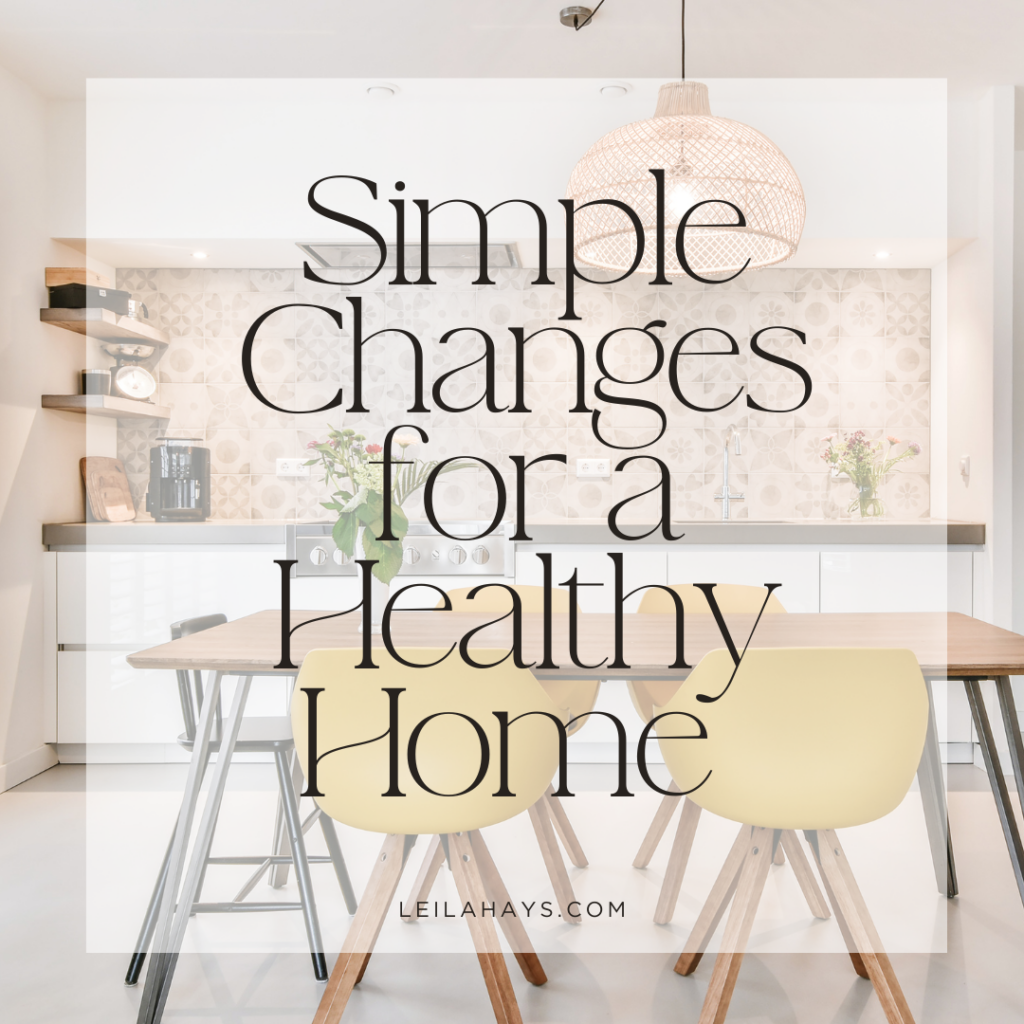Now more than ever, we need our homes to be a sanctuary — a place where we feel safe, refreshed, and joyful. My 4-week series, How to Create a Happy and Healthy Home Inside and Out, is here to help you make that happen! Best of all, you’ll discover simple, budget-friendly ways to improve your home’s health, functionality, and freshness.
Let’s kick things off by focusing on the health of your home.

If you’re someone who puts effort into eating right and staying active, you’re already doing great things for your health. But have you ever stopped to think about whether your home is doing the same?
We spend a huge portion of our lives indoors. And the reality is, your home could be contributing to health issues like asthma, allergies, fatigue, headaches — even more serious concerns with long-term exposure. The good news? You can absolutely take steps to turn things around.
Improving your home’s health doesn’t have to be expensive or overwhelming. In fact, many of the changes you’ll read below are easy, effective, and totally doable.
Banish Dust Bunnies
Dust does more than just make your home look messy — it can seriously affect air quality and trigger health problems like asthma or COPD.
Dust is a mix of dead skin cells, pet dander, pollen, fibers, and soil. It also attracts mold spores and dust mites (tiny critters that feed on skin flakes). Think of that next time you spot a dust bunny under the bed!
What to do:
- Vacuum regularly with a HEPA filter — focus on carpets, drapes, blinds, upholstery, and air vents.
- Use damp microfiber cloths or electrostatic mops to trap dust instead of kicking it into the air.
- Deep-clean bedrooms: encase your mattress and box spring with allergen-proof covers, and wash bedding weekly in hot water (130°F or higher).
- Control humidity: aim for 40–50% and use a dehumidifier if needed.
- Declutter to reduce dust traps. Less stuff = fewer hiding spots for allergens.
- Sanitize toys often, especially plush ones — stick them in the freezer overnight to kill dust mites.
- Replace carpets with hard flooring where possible.
- Consider duct cleaning only if you suspect mold, pests, or heavy buildup.
- Keep shoes at the door to prevent tracking in outdoor toxins like pesticides, bacteria, and more.
Let the Fresh Air In
Modern homes are built tight to save energy — but that also traps allergens and pollutants inside. In many cases, indoor air can be worse than outdoor air.
What to do:
- Open windows regularly to bring in fresh air and move pollutants out (check outdoor air quality first).
- Change HVAC filters every 2–3 months to keep air circulating cleanly.
- Invest in a portable air purifier with a HEPA filter for bedrooms or living areas.
- Upgrade to a whole-house air filtration system for even more powerful cleaning.
- Add houseplants like snake plants, Boston ferns, and peace lilies to help purify the air — and boost your mood too!
Check Product Labels for Toxins
Many everyday items release harmful chemicals into your home’s air and dust — from cleaning sprays to couches to candles. These toxins can build up over time and impact your health.
The upside? Healthier, non-toxic alternatives are easier to find than ever.
What to do:
- Choose solid wood furniture over engineered wood to avoid formaldehyde emissions.
- Opt for furnishings made from cotton, linen, or wool. Avoid polyurethane foam.
- Skip flame retardants and chemical fabric treatments — look for labeled sofas made after 2015.
- Air out new furniture and carpets before bringing them inside to reduce off-gassing.
- Freshen air with soy candles, essential oils, or natural diffusers. Avoid paraffin wax and high-VOC products.
- Use safer cleaning supplies — look for the EPA’s “Safer Choice” label or make your own with vinegar, lemon, and baking soda.
- Ditch old Teflon pans. Stainless steel and cast iron are safer long-term choices.
- Choose fragrance-free when possible — many scented products contain hidden endocrine disruptors like phthalates.
- Use low-VOC or natural paint, especially in older homes where lead paint may still be present.
Dilute Moisture and Water Issues
Water can be a blessing — or a hazard. Moisture issues can lead to mold, mildew, and poor water quality, all of which impact your health.
What to do:
- Reduce humidity and dampness in basements, attics, and bathrooms. Use exhaust fans, dehumidifiers, and check for leaks.
- Address any mold or mildew immediately — bring in a pro for large jobs.
- Fix leaks promptly to avoid mold growth and water damage.
- Check your local water quality report, especially if your home has older plumbing.
- Use a carbon filter pitcher or install a filtration system to remove lead, chlorine, and other contaminants.
Your home should help you feel your best — not wear you down. I hope these simple, practical tips help you make your home healthier and happier for you and your family. Start small, stay consistent, and don’t stress about doing it all at once.
Stay tuned for next week’s post in the series!
Hi, there!
I'm Leila Hays, and I'm on a mission to help you buy and sell at the same time without paying two mortgages or moving twice. If you're planning to make a move in the next year, it's not too early to plan. Click the link below to get started.
Contact
832-402-6040
9303 New Trails Dr. Ste. 165
The Woodlands, TX 77381
leila@leilahays.com
what you need to know about buying or building
Homes You Might Love
(my listings)
what you need to know about owning or selling
All Articles
schedule your free consultation